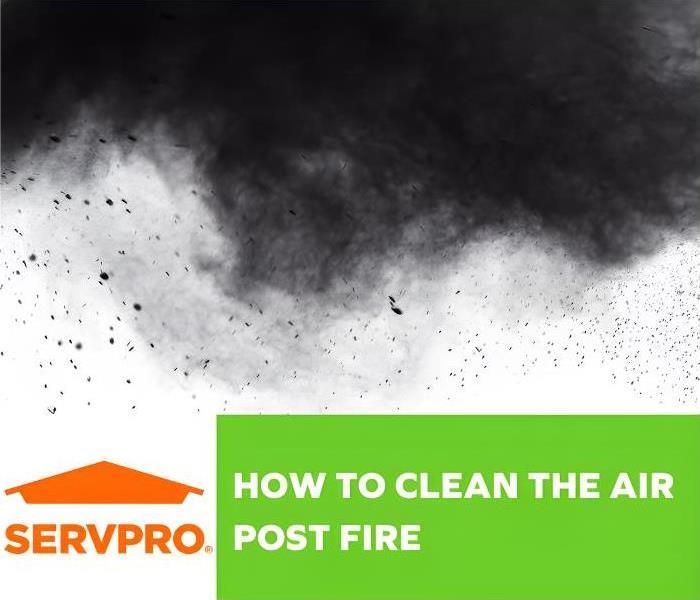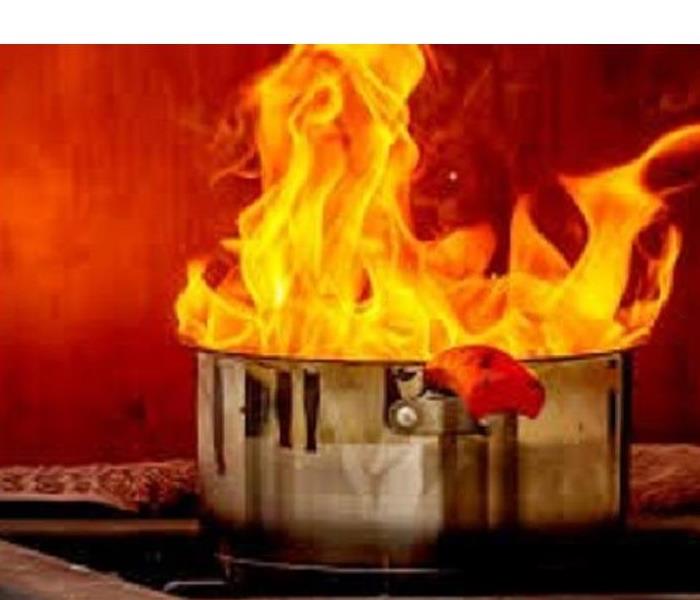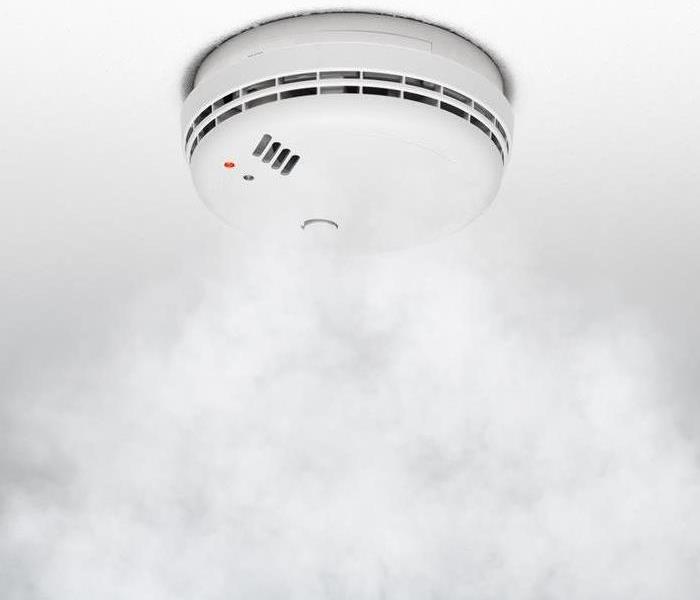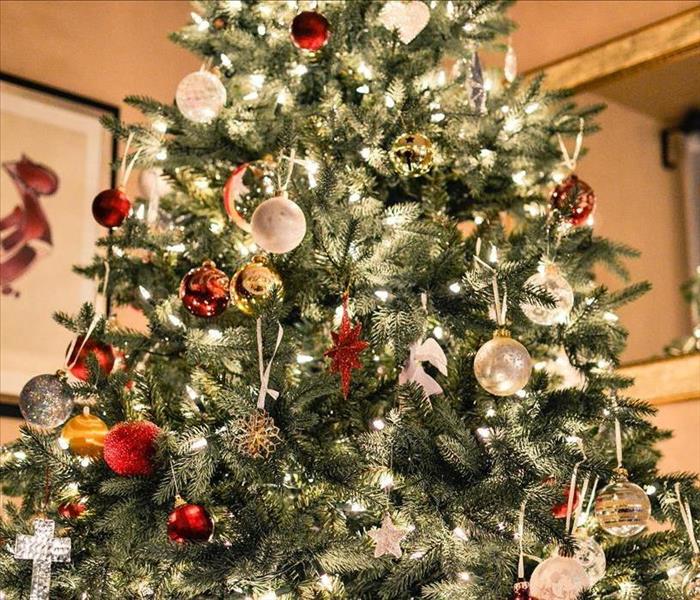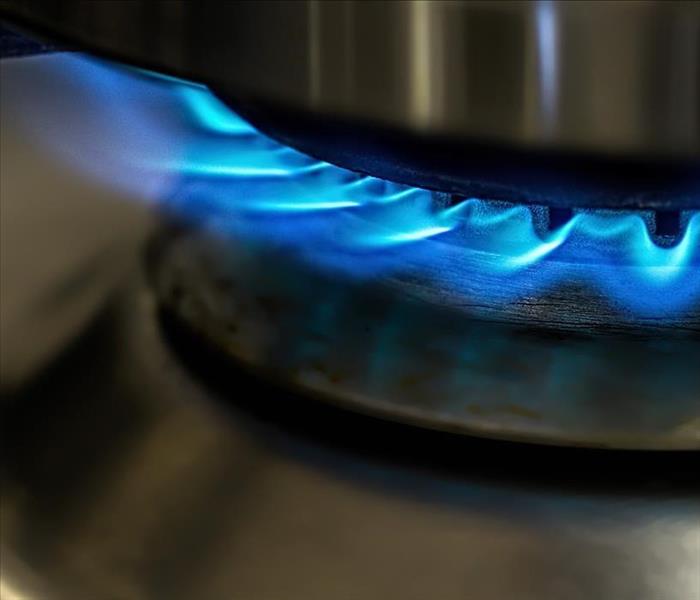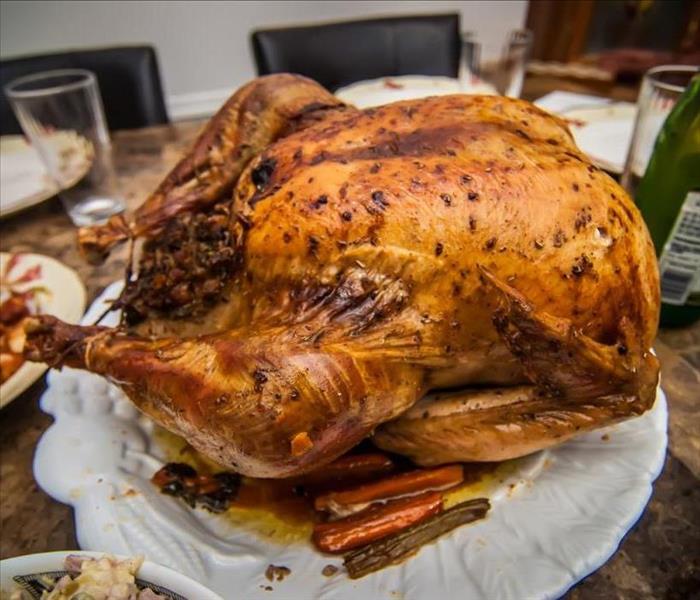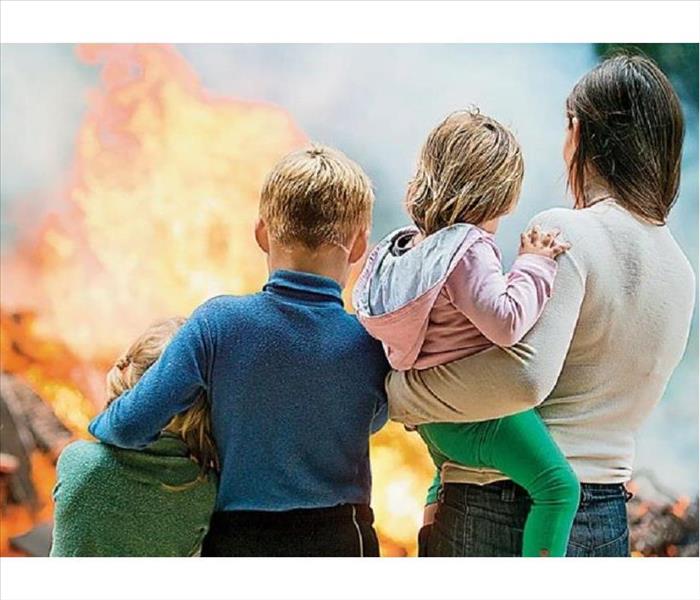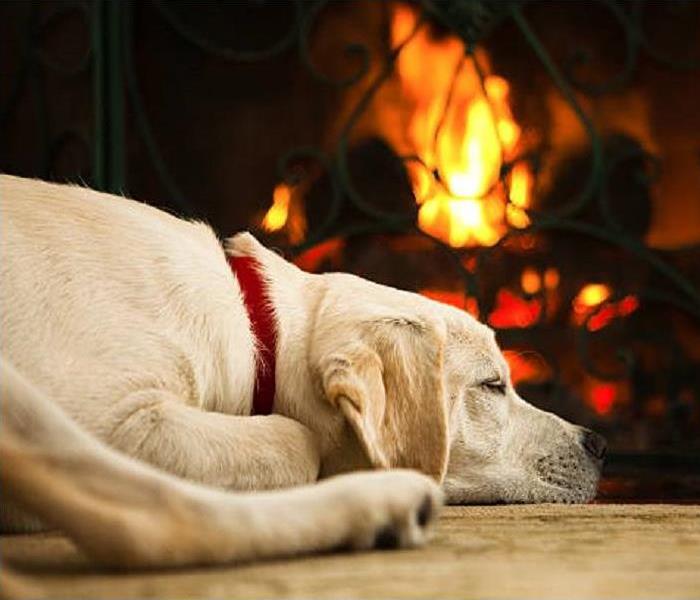Archived Fire Damage Blog Posts
Can I Stay at my Home After a Fire?
6/9/2022 (Permalink)
After enduring a small-medium fire in your home, it may be tempting to stay. After all, the fire may have been small and confined to a certain area of the house.
Prioritize your safety!
In order to help restore your home, technicians may use...
- Strong Deodorizers
- Fogging Techniques
- Turn off your Power for safety purposes
These instances usually require the property to be vacant for a period of time. Our goal is to quickly and safely restore your home, so you have as little interruption as possible.
Firefighters Use Water to Extinguish a Fire
Excess moisture on top of fire & smoke damage can make the restoration more challenging. SERVPRO® technicians are trained and qualified to safely remove water and fire damage to prevent further damage to your property.
Effects of Smoke Damage
Smoke & soot from a fire release dangerous carcinogens that can harm one's health without even knowing it. This can pose a further threat to one's health while remaining at your home after a fire.
Each situation is different, but clearly there are benefits to vacating your home for a time and letting professionals take the lead in restoring your home.
When a disaster strikes, SERVPRO® is here to help. Call SERVPRO® of Tustin for your disaster recovery needs. From Fire and Water Damage to sanitization, we are there to assist you. Call us at: (714) 480-1340
How to Clean the Air Post Fire
5/13/2022 (Permalink)
If you've ever been into a recently burned property, you're aware of the sting in your nose. It's unpleasant & hazardous. The odor is sulfur mixed with smoke. It's called Acrid. This needs to be removed from the property before the residents can reoccupy it. What’s the best way to get rid of it?
Smoke contains the residue of all the burned materials and it can be Caustic. Special equipment is used to completely clean the air.
- Ozone Machines
- Air Scrubbers
Ozone Machines destroy the Molecules, Bacteria, and Spores that cause unpleasant smells. Air Scrubbers clean the air by repeatedly moving it through HEPA filters which help reduce the smell.
What else is involved?
Other necessary steps involve: (1) Clean all the hard surfaces (2) Wash or treat clothes, drapes, carpets, and upholstery.
A fire doesn’t always destroy a building, smoke however, can ruin everything it contacts. Make sure you do all that’s needed to “clear the air.”
SERVPRO® of Tustin is here to help with all your fire damage needs. We are open 24/7, 365 days a year to help you get back to normal. Call us at (714) 480-1340
Wildfire Cleanup | Phase I & II
5/2/2022 (Permalink)
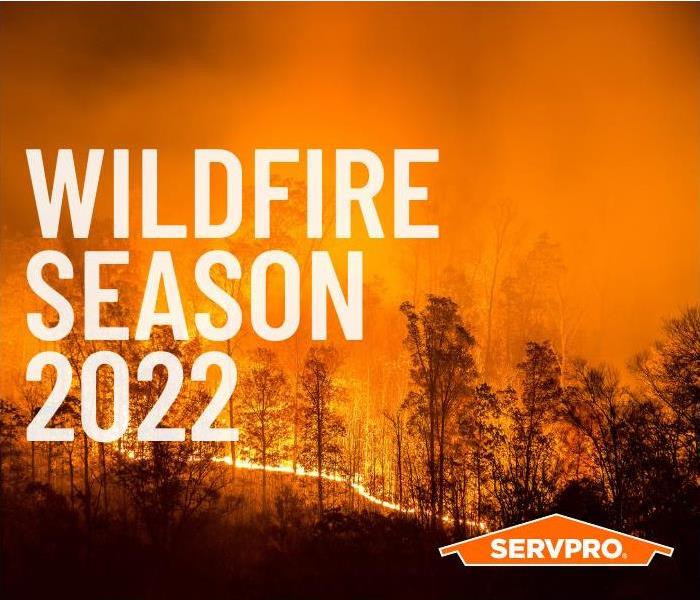 Our highly skilled and trained crew will provide visual assessments and determine the best solution for your property clean-up.
Our highly skilled and trained crew will provide visual assessments and determine the best solution for your property clean-up.
Phase I: Inspection
Assisting in Wildfire Clean-up all starts with the inspection. If your property was near a wildfire, the possibility of Smoke Damage is high. Smoke particles can sometimes be clearly visible, other times a more thorough inspection must take place. We look for where smoke settles... baseboards, windowsills, shelves, mantels, door frames, and other locations.
Extensive damage requires establishing what hazardous materials are present. All hazardous materials must be addressed and removed before Ash and Debris can be removed.
Phase II: Cleaning & Removal
Smoke Damaged is addressed in three parts, 1) HEPA vacuum, 2) the wipe down, and 3) odor removal.
A HEPA vacuum is used to collect loose particles. After all the surfaces are vacuumed, surfaces are wiped with a microfiber cloth. With the use of Microfiber Technology, affected surfaces are wiped down and cleaned. Microfiber Cleaning Cloths can collect particles at a .3 micron level, while smoke particles are commonly 1 micron in size. After the wipe down, the surfaces will be HEPA vacuumed once more to collect fallen particles. O-zone Machines & Hydroxyl Generators are specialty equipment that cleans the air, breaking down odor molecules.
For extensive wildfire clean-ups, after hazardous materials are removed, Ash and Debris can be discarded and the remaining structure can be cleaned. If reconstruction services are required, our Director of Construction is available to address your reconstruction needs.
SERVPRO® of Tustin is Your Wildfire Clean-up Team!
You don't need to handle Wildfire clean-up on your own. For the safety of everyone around, professionals should be tasked to handle and dispose of hazardous materials and debris. SERVPRO® of Tustin specializes in clean-up services, including Fire Clean-up.
Our highly skilled and trained crew will provide visual assessments and determine the best solution for your property clean-up.
Wild Fire season is coming! Call SERVPRO® of Tustin to schedule an inspection of your property! (714) 480-1340
3 Steps to Prevent Fires at Your Business
4/24/2022 (Permalink)
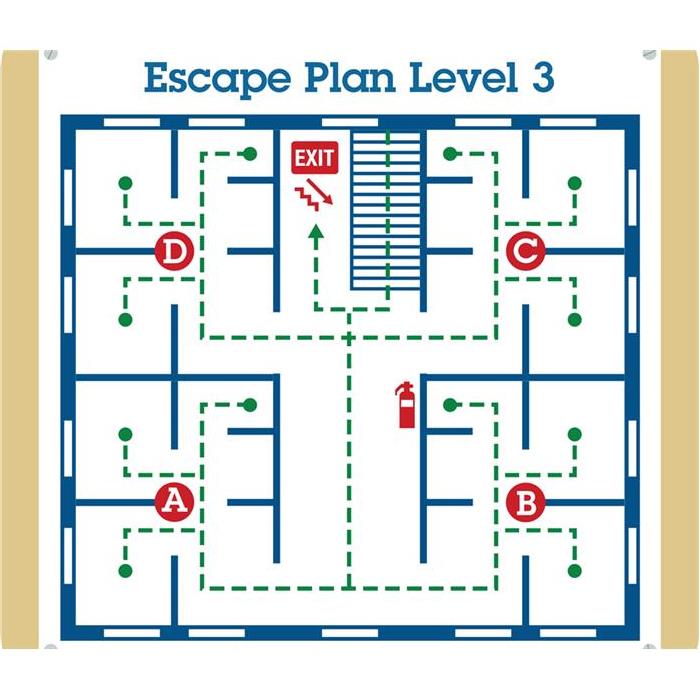 Make sure your employees know the fire evacuation plan and practice it!
Make sure your employees know the fire evacuation plan and practice it!
Prevent fires in your business with these 3 steps
As a business owner, you must plan to protect your employees and customers. Without proper preparation, a fire could have deadly consequences. Follow the three steps below and help protect and guide your employees in case of a fire.
1. Perform a Risk Assessment
Evaluate your property and check for any possible risks that may lead to a fire. This may include any open flames, old electrical wiring, or overloaded outlets. This first step is crucial in knowing what could go wrong.
2. Test Fire Protection Equipment
Fire Protection equipment includes Smoke Detectors and Fire Extinguishers. These items need to be tested and replaced occasionally. Note these items so they will always stay current.
3. Create & Practice an Evacuation Plan
Have a floor plan for your facility. Mark the exit routes and have the plan visible to your employees. Practice the plan so everyone will be prepared in case of a Fire.
Take the time to prepare your facility for a Fire. Don't overlook these important safety tips!
SERVPRO® of Tustin is here for all your Fire Restoration needs. Contact us 24/7 for emergency services at (714) 480-1340.
Home Fire Evacuation Plan... for Pets
12/9/2021 (Permalink)
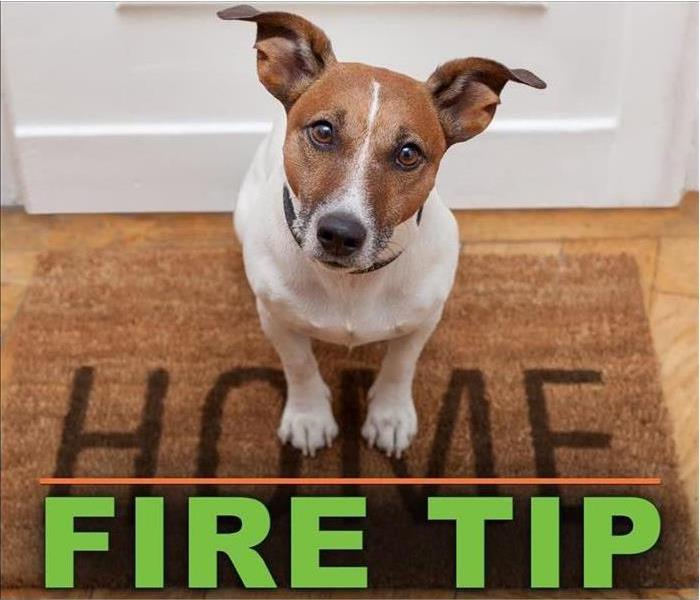 Practice the evacuation plan several times with your pet.
Practice the evacuation plan several times with your pet.
If a fire occurs in your Tustin home or the surrounding OC area, your first priority is to get yourself and your family members out safely. While there are many things you will leave behind to get, you will likely not want to leave your pets behind. Do you have a plan in place to evacuate your pets in case of a fire emergency? Start by including your pets into your home escape plan.
5 Tasks to Prepare Your Pet
Protecting your pets from a fire takes preparation. Here are several steps you can take to better the chance of their rescue:
1. Keep your pet in rooms or areas that are easily accessible to firefighters.
2. Update your pet alert window cling on the front window of your home.
3. Set aside a disaster supply kit just for your pet. Include any medication or supplies you may need.
4. Place important pet ownership documents and proof of vaccinations in a firebox that you can easily retrieve.
5. Teach your pets the “Come” command so you can easily direct them towards you in an emergency.
Creating Your Pet Evacuation Plan
In addition to these important pet safety tasks, you will need to create a pet evacuation plan. Assign an individual or two to be in charge of retrieving the pets. If your pets are located in a specific part of the house during the night, identify several different routes to that location. Practice the evacuation plan several times with your pet.
In the event of an evacuation due to a wildfire, have arrangements in place for your pet to stay.
Keep your pets and family members safe by having a well-thought-out plan if a fire emergency does occur. Never risk your safety or the safety of a family member to save your house pet. While your pets might be able to escape safely on their own, you can increase the chance of their rescue with these tips!
Smoke Alarm Safety Tips for in Tustin?
7/12/2021 (Permalink)
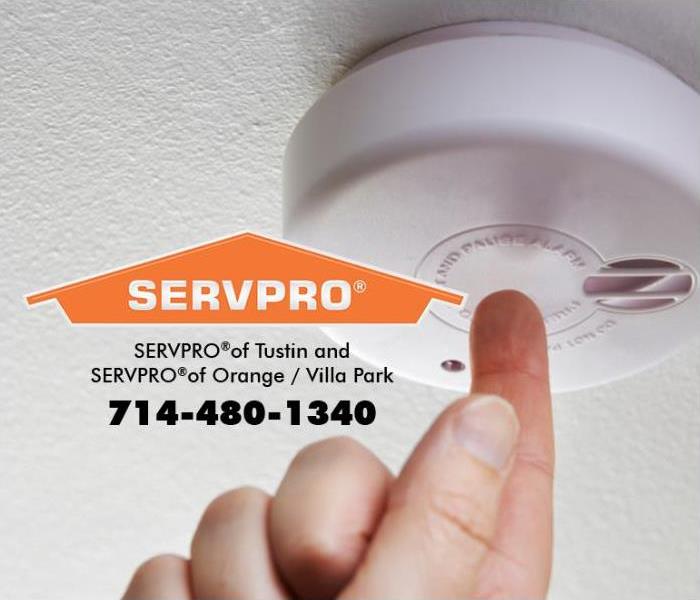 We respond to fire damage emergencies 24-hours a day in Orange County.
We respond to fire damage emergencies 24-hours a day in Orange County.
Smoke Alarms Save Lives in Tustin.
Do you recall the last time you inspected your home’s smoke alarm system? For over thirty years SERVPRO® of Tustin and SERVPRO® of Orange/Villa Park have been responding to fire damage emergencies in Orange County and we have witnessed firsthand the difference smoke alarms can make. Here is some information from the National Fire Protection Association about smoke alarms:
Smoke Alarms Safety Tips
- A closed-door may slow the spread of smoke, heat, and fire
- Install smoke alarms in every sleeping room and outside each separate sleeping area
- Install alarms on every level of the home
- Smoke alarms should be interconnected so when one sounds, they all sound
- Large homes may need extra smoke alarms
- Test your smoke alarms at least once a month. Press the test button to be sure the alarm is working.
- When a smoke alarm sounds, get outside and stay outside
- Replace all smoke alarms in your home every 10 years
Call Us Today!
When your home or commercial business is damaged by fire, SERVPRO® of Tustin and SERVPRO® of Orange/Villa Park are Here to Help. ® Our technicians are on-call 24-hours a day in Tustin to respond to fire damage emergencies. Call us today at 714-480-1340. We’ll restore your fire damage, “Like it never even happened.”
Franchises are Independently Owned and Operated.
Candle Fire in Lake Forest Bedroom?
6/2/2021 (Permalink)
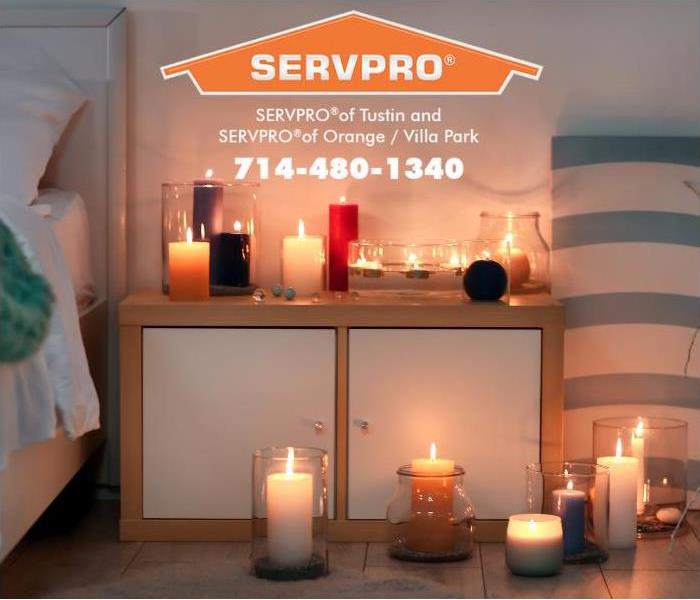 We are trusted leaders of fire restoration in Orange County.
We are trusted leaders of fire restoration in Orange County.
Candle Fire in the Bedroom?
According to the National Fire Protection Association (NFPA), roughly one-third of home candle fires started in bedrooms between 2014 and 2018. SERVPRO® of Tustin and SERVPRO® of Orange/Villa Park respond to fire damage emergencies throughout the year in Lake Forest, and we see the damage candle fires cause.
Here are some candle safety tips from the NFPA:
- Be sure to blow out all candles when you leave the room or go to bed
- Avoid the use of candles in the bedroom and other areas where people may fall asleep
- Keep candles at least one foot away from anything that can burn
- Never leave a child in a room alone with a burning candle
- Use candle holders that are sturdy and won’t tip over easily
- Put candle holders on a sturdy, uncluttered surface
- Light candles carefully
- Don’t burn a candle all the way down
- Put it out before it gets too close to the holder or container
- Never use a candle if oxygen is used in the home
- Never use candles during a power outage (use flashlights)
Call Us Today!
SERVPRO® of Tustin and SERVPRO® of Orange/Villa Park have a team of highly trained technicians on-call and ready to respond to your fire damage emergency 24-hours a day in Lake Forest. Call us today at 714-480-1340.
SERVPRO of Tustin and SERVPRO of Orange/Villa Park are Independently Owned and Operated.
Smoke-damaged Jewelry in Orange?
5/11/2021 (Permalink)
 We are trusted leaders in fire restoration in Orange County.
We are trusted leaders in fire restoration in Orange County.
Smoke and Soot Damage in my Orange home - Yuck!
At SERVPRO® of Tustin and SERVPRO® of Orange/Villa Park, our fire restoration technicians are trained and certified by the Institute of Inspection, Cleaning and Restoration (IICRC), the nonprofit certifying body for the restoration industry. Our technicians are specially trained to use a wide range of cleaning products and techniques and they will pretest every item to ensure it is salvageable before beginning the cleaning and restoration process. Depending on the items being restored, they may use any, or a combination of, the following cleaning techniques:
- Dry Cleaning - Used for cleaning light residues or to pre-clean prior to wet cleaning
- Wet Cleaning - An effective cleaning method for removing moderate to heavy residues
- Spray and Wipe -Effective for items that can’t withstand wet cleaning
- Foam Cleaning - Used for upholstery fabrics that might shrink or bleed if wet cleaned
- Abrasive Cleaning - Involves agitation of the surface being cleaned
- Immersion Cleaning - Contents are dipped into a bath of the cleaning product
Call Us!
When you have a fire damage emergency in your Orange home, SERVPRO® of Tustin and SERVPRO® of Orange/Villa Park are ready to respond 24-hours a day. We will always treat you and your family with empathy and handle your keepsakes and belongings with great care. Call us today at 714-480-1340.
SERVPRO of Tustin and SERVPRO of Orange/Villa Park are Independently Owned and Operated.
Keep Your Tustin Office Prepared for Fire
4/24/2021 (Permalink)
Office fires in Tustin are more common than you might think. If you have a break room in your office or small business, it probably contains a coffee maker, microwave, refrigerator, and/or other small appliances. You should also include a fire extinguisher in there somewhere! SERVPRO of Tustin and SERVPRO of Orange / Villa Park want to remind you that fires can start as easily as turning on one of these appliances. There could be a short somewhere in the wiring or something inside the microwave could catch fire. Unfortunately, the possibilities are real and they do happen. Your workplace should have a training session on how to use fire extinguishers. If the owner of the business has not done that, please look into setting up a training session. Local fire departments are usually happy to assist with this training, and they can provide some real-life examples of ways to practice fire safety.
If your break room (or any other area of your office building) catches on fire, you will likely have smoke damage as well as damage from the fire. That is where SERVPRO of Tustin and SERVPRO of Orange / Villa Park come in. We are here to clean up the damage and make your Tustin building look new again. We are open 24/7 and we show up prepared. Please do not hesitate to call us if you need our services. We are Here to Help.
SERVPRO of Tustin and SERVPRO of Orange / Villa Park are independently owned and operated.
Pet Fire Damage in Irvine?
4/14/2021 (Permalink)
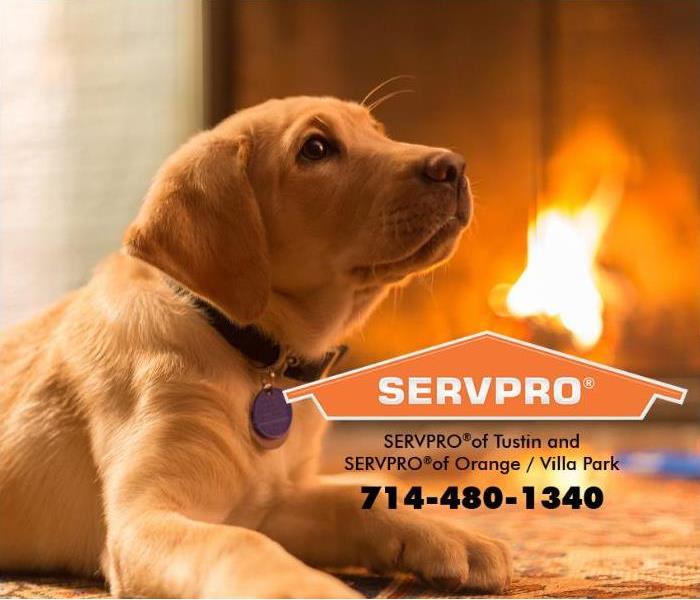 We respond to fire damage emergencies 24-hours a day in Orange County.
We respond to fire damage emergencies 24-hours a day in Orange County.
Pets and Fire Safety Tips
Did you know that pets and wild animals are partly responsible for starting about 750 home fires in the United States each year? According to the National Fire Protection Association (NFPA) pets are partly responsible for starting fires involving cooking equipment, fireplaces and chimney, space heaters, lamps, bulbs, wiring, and candles. SERVPRO® of Tustin and SERVPRO® of Orange/Villa Park have been mitigating fire damage emergencies in the Irvine area for years. Here are some safety tips from the NFPA to keep your pets safe around fire:
Safety Tips
- Pets are curious. They may bump into, turn on, or knock over cooking equipment. Keep pets away from stoves and countertops
- Keep pets away from candles, lamps, and space heaters
- Always use a metal or heat-tempered glass screen on a fireplace and keep it in place.
- Keep pets away from the chimney’s outside vents and have a “pet-free zone” of at least three feet away from the fireplace. Glass doors and screens can stay dangerously hot for several hours after the fire goes out.
- Watch pets to make sure they don’t chew through electrical cords.
Call Us Today!
SERVPRO® of Tustin and SERVPRO® of Orange/Villa Park has a team of highly trained restoration technicians on-call 24-hours a day to respond to fire damage emergencies. Call us today at 714-480-1340. We’ll clean and restore your fire damage in Irvine, “Like it never even happened.”
SERVPRO of Tustin and SERVPRO of Orange/Villa Park are Independently Owned and Operated.
Arson Fires in Tustin
4/5/2021 (Permalink)
SERVPRO of Tustin and SERVPRO of Orange / Villa Park want you to be aware of the causes of fire damage and fire injuries so that you can help prevent them.
Top Causes of Fires in Tustin:
- Arson & intentional fires. An “intentional fire” is one that is not set to cause harm, but it gets out of control. Arson is a fire that is set to cause harm. Most of the time, arson and intentional fires are set outside. Deaths, injuries, and fire damage usually happen indoors
- Candles. SERVPRO of Tustin and SERVPRO of Orange / Villa Park has more information here.
- Cooking. Kitchen fires are the leading cause of home fire injuries and home fire damage
- Electrical. Use all electrical equipment according to the directions
- Heating. Heating equipment is the second most common cause of death in home fires
- December, January, and February are the months that have the most home heating fires
- Smoking. Cigarettes, cigars, pipes, and other smoking materials are the biggest cause of fire deaths in the U.S. Think of preventing tragedy when explaining why to quit smoking
- Children. Children should never be left alone with matches, lighters, candles, or other dangerous materials. Children playing with fire cause hundreds of deaths and injuries every year
Please pay attention to fire safety. While we can help restore your City or County home or office, prevention and family safety should always come first. Share this blog with a friend who might want to learn more about fire prevention.
SERVPRO of Tustin and SERVPRO of Orange / Villa Park are independently owned and operated.
Links:
https://www.nfpa.org/Public-Education/By-topic/Top-causes-of-fire
The Fire Triangle vs Fire Extinguishers
12/15/2020 (Permalink)
Fire is rapid oxidation (combustion) involving three components; fuel, oxygen and heat. Once started, for a fire to continue to burn all three elements must be present. These components form what is called the Fire Triangle. Eliminate one leg of the triangle and the fire goes out. Different types of fire extinguishers work by eliminating one or more of the legs of the fire triangle.
There are four main types of fire extinguishers, water, dry powder, foam and CO2. The most common fire extinguisher is water. These are tanks filled with water and a propellant such as nitrogen or carbon dioxide. They work by mainly removing heat; additionally they also help by restricting the oxygen supply. Water extinguishers attack two legs of the fire triangle.
The second type, dry powder extinguishers, are tanks filled with a dry chemical and pressurized with nitrogen. The dry chemical is designed to absorb heat, melt and coat the fuel. This reduces flammable vapors and cuts off the oxygen supply to the fuel. Monoammonium phosphate is the most common dry powder. Others include sodium bicarbonate and potassium bicarbonate.
The third type of extinguisher is carbon dioxide. This consists of a tank filled with liquid and gaseous carbon dioxide. When the liquid is released from the tank it rapidly expands and turns into gas. When turning into a gas a great amount of heat is absorbed taking out one leg of the triangle. The carbon dioxide also envelopes the fuel cutting off the oxygen thereby taking out a second leg of the triangle.
The fourth type is the foam extinguisher also known as AFFF (aqueous film-forming foam). This consists of a tank of water and a foaming agent pressurized with nitrogen. The water and foaming agent are mixed as they exit the nozzle forming foam that coats the fire preventing oxygen from reaching the fuel. It also absorbs heat since the foam is mainly water. Foam attacks two legs of the triangle.
GREASE FIRE DANGERS
9/14/2020 (Permalink)
Cooking causes over 170,000 home structure fires annually, and is considered to be the number one cause of home fires and home injuries. Of the annual number of fires started in the kitchen, over 70% of the fires were started by food or other cooking materials. Often these fires are ignited by grease.
Tips to prevent grease fires:
- Stay in the kitchen while you are frying, grilling, boiling or broiling food. The leading cause of fires in the kitchen is unattended cooking.
- Keep anything that can catch fire away from your stovetop.
- Remove as much moisture as possible from the food you are cooking, before putting it in hot oil.
- Keep the grease at the recommended temperature. If you see any smoke or the oil smells, it is an indication that the grease has become too hot and is burning.
- Keep a lid near the pan you’re cooking with so that it is accessible if a fire starts, quickly place on the pan to prevent spread, and extinguish the fire.
In addition to these tips, it is also a good practice to be mindful of times grease fires are more likely to occur. Thanksgiving is the peak day for home cooking fires, followed by Christmas Eve and Christmas Day.
By using proper cooking techniques and best practices, frying with grease or oil should pose a relatively small risk. Quick and proper reaction will minimize any damage and prevent injury.
FIRE & SMOKE DAMAGE RESTORATION
9/3/2020 (Permalink)
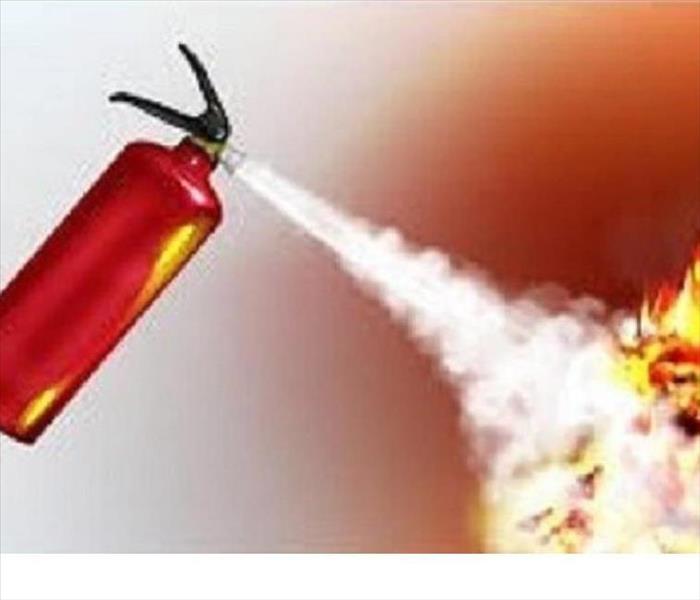 Fire extinguisher putting out fire
Fire extinguisher putting out fire
Fire and Smoke damage should only be handled by a professionally trained crew that will work hard for you. SERVPRO of TUSTIN, has the certification to remove all signs of fire and smoke damage. The first 24 to 48 hours are the most important hours in preventing further damage that can add more time and expense to fire and smoke damage.
Smoke damage can also contain chemicals that can pose health risks. These chemicals can be carried throughout your home and/or business and will cling to nearly anything, leaving noxious odors and soot everywhere. We have the experience and expertise to assess the full extent of the damage and put together a proactive plan for remediation.
We work directly with your insurance company, with over 36 years of extensive knowledge and experience working with all carriers.
When it comes to fire and smoke damage, it takes a trained eye to understand the damage and what is required to safely clean and restore the property. Our experienced crew is available 24/7 with same day emergency service, using professional-grade equipment to quickly eliminate residual odors.
714.480.1340
Does Your Home Have Damaged Caused By Fire
2/26/2020 (Permalink)
Was your home recently damaged by a kitchen or other source of fire/smoke? Are you searching the web for DIY tips on how to clean up the damage yourself? Here are four reasons why you may want to hire a professional restoration company.
Hidden Health Hazards
Unfortunately, the dangers of a fire don’t end once it’s extinguished. Smoke and soot damaged structure and contents has lingering residue which could be hazardous to your health. Soot is the residue from the incomplete combustion of objects. Organic materials, plastic, foam, textiles and other household materials don’t burn cleanly. The soot produced can be the result of the chemical reaction caused the extreme heat of the fire or from materials that didn’t burn completely.
If the materials disturbed contains toxic chemicals, the soot particles floating in the air may contain cancer-causing asbestos fibers, ammonia, tar, formaldehyde, etc. Walking through your fire-ravaged home could allow chemically-laden soot to get into your eyes, lungs and skin.
Exposure to soot in a fire-damaged home is obviously at its highest during the cleanup process. This is why professionals take the precautions of testing, wearing personal protective equipment as needed. If the cleaning is not done completely, the health effects of smoke could linger for years. Leave fire restoration to professionals who can employ deep-cleaning techniques to truly restore your home to its pre-fire condition.
Specialized Equipment, Products and Know-How
Cleaning solutions and a dust mask are not nearly enough to adequately clean up fire and smoke damage. Common household products and cleaning techniques are not always sufficient to clean up the soot and odor. A thorough cleaning of the structure and contents in the home eliminates the residual odors and removes the lingering health threats of fire residue. Professional tools and the knowledge of proper cleaning techniques – are at the heart of a thorough, safe fire restoration.
Also, be aware that laundering smoke-damaged clothing in your washer could deepen the damage and leave undesired odors in the washing machine. Fabric/Garment Restoration professional have the techniques to clean and salvage contents damaged in a fire.
Salvageable Furniture and Other Household Goods
Experienced restoration professionals can assess what can be restored and what is damaged beyond repair/restore. With advanced recovery techniques, a fire restoration contractor can help minimize your losses and restore or treasures. But, if an item is beyond repair and are truly unrecoverable a restoration professional will inventory the items and then and dispose of them properly.
Restoration Professionals Expedite the Process
Restoring your home back to its pre-fire damage condition is not a straightforward task. There are belongings to salvage, cleanup to do, and the home’s structure to repair. Then, there is working with the insurance company and their claim’s process. The entire process is a headache to attempt yourself.
In fact, your efforts to save money with DIY fire restoration could easily backfire if you throw out salvageable belongings and don’t complete insurance claims correctly. The time it takes to perform the cleanup without help could also be detrimental. More damage can occur if soot is not cleaned up promptly. Relying on a fire restoration contractor who’s familiar with every aspect of the disaster recovery process is a much better option.
Schedule Professional Fire Restoration Services
SERVPRO of Tustin’s team is ready to respond and provide affordable, convenient fire and smoke damage restoration services. We make the recovery process as quick and painless as possible. Contact us today to learn more about our fire restoration services.
College Campus Fire Safety Tips
1/20/2020 (Permalink)
For many college students, living in a dorm during their freshman year of college is the first time they’ve lived away from home and, subsequently, without the supervision of their parents/guardians. Before heading off for their first year of dorm living, new college students should read over this list of safety tips and take a few minutes to make sure that they are living in a fire-safe environment. It’s probably beneficial for returning college students to give this list a read through too; whether living in the dorms or off-campus, safety tips should not be overlooked.
Learn the building’s evacuation plan.
If you’re living on campus, chances are your dorm will have an emergency evacuation plan. Once you’re all settled into your new home, take some time to familiarize yourself with the building and learn the evacuation routes. Practice multiple escape routes in the event that your first option is obstructed during an emergency. Most college campus buildings should have an evacuation plan posted on each floor. If you live off-campus, have an escape plan of your own with at least two ways out of each room. Knowing what to do before an emergency happens can help you to protect yourself as well as others.
Don’t overload your room’s electrical outlets.
Most electrical outlets in dorms are designed to handle a specific amperage. It’s best not to try to push them to their capacity by using too many multi-plug devices. Your school may also have policies restricting the use/plug-in of certain appliances. These limitations are meant to limit the number of potential electrical and fire hazards in your dorm. If you ever notice any scorched marks or burning odors around an electrical outlet, stop using that outlet and inform someone of the problem right away.
Cook with care.
Be careful when cooking in your dorm or in the dorm’s community kitchen. Cooking equipment is involved in 86 percent of dormitory fires. If you do not have a kitchen in your dorm, then you should follow the school’s guidelines on what sort of plug-in cooking equipment is permitted for use in the dorms. Always be careful with electric frying pans, toasters, toaster ovens, microwaves, etc. Never leave your dorm when cooking appliances are in use.
Respect open flame policies.
Most schools don’t allow you to smoke or burn candles or incense in the dorms. If you do smoke, be sure to do so in the designated areas on campus (most likely away from buildings). If your school does not allow smoking on campus, then you should follow that policy. Avoid burning candles or incense in your dorm room. If you burn them for the smell, try using essential oil diffusers to create a pleasant aroma in the dorm. You can also buy battery-operated flameless candles for the same flickering light/ambiance that a candle provides, but without the fire hazard. If you do still choose to burn candles or incense in your dorm, never leave them unattended and keep them away from flammable materials.
Don’t tamper with fire safety features in your dorm.
Most dorms should have smoke detectors. It is important that you do not cover them with any decorations in your dorm. Additionally, do not remove the batteries in your dorm’s smoke detector. It will send a signal to Public Safety to investigate the source of the problem. It is also important to have fresh batteries in your smoke detector so that it can properly do its job to keep you safe. If your dorm has a sprinkler system in place, don’t hang any decorations on it. Sprinklers are there to help put out a fire before firefighters can get there. They are especially important if your dorm is on an upper level as it can be more difficult for firefighters to get to the flames.
Be mindful of clutter and how you decorate your dorm.
While decorating your dorm is how you can display your personality or bring some of home to school with you, it can also become potential fuel for a fire. Every poster or tapestry you hang on the wall, or piece of decor you hang from the ceiling, can be considered a fire hazard. Some schools may limit the amount of wall space that can be covered in your dorm, or may prohibit hanging things from the ceiling. Even if there are no restrictions, it would be wise to limit the amount of decor you hang in your room as well as to keep clutter to a minimum. Additionally, avoid draping materials over hot items like lamps that could potentially cause ignition. Furniture should also be kept away from the room’s heat source to reduce the risk of fire.
Did You Have A Recent Fire?
1/15/2020 (Permalink)
Was your home recently damaged by a kitchen or other source of fire/smoke? Are you searching the web for DIY tips on how to clean up the damage yourself? Here are three reasons why you may want to hire a professional restoration company.
Specialized Equipment, Products and Know-How
Cleaning solutions and a dust mask are not nearly enough to adequately clean up fire and smoke damage. Common household products and cleaning techniques are not always sufficient to clean up the soot and odor. A thorough cleaning of the structure and contents in the home eliminates the residual odors and removes the lingering health threats of fire residue. Professional tools and the knowledge of proper cleaning techniques – are at the heart of a thorough, safe fire restoration.
Also, be aware that laundering smoke-damaged clothing in your washer could deepen the damage and leave undesired odors in the washing machine. Fabric/Garment Restoration professionals have the techniques to clean and salvage contents damaged in a fire.
Salvageable Furniture and Other Household Goods
Experienced restoration professionals can assess what can be restored and what is damaged beyond repair/restore. With advanced recovery techniques, a fire restoration contractor can help minimize your losses and restore your treasures. But, if an item is beyond repair and are truly unrecoverable a restoration professional will inventory the items and then and dispose of them properly.
Restoration Professionals Expedite the Process
Restoring your home back to its pre-fire damage condition is not a straightforward task. There are belongings to salvage, cleanup to do, and the home’s structure to repair. Then, there is working with the insurance company and their claim’s process. The entire process is a headache to attempt yourself.
In fact, your efforts to save money with DIY fire restoration could easily backfire if you throw out salvageable belongings and don’t complete insurance claims correctly. The time it takes to perform the cleanup without help could also be detrimental. More damage can occur if soot is not cleaned up promptly. Relying on a fire restoration contractor who’s familiar with every aspect of the disaster recovery process is a much better option.
Schedule Professional Fire Restoration Services
SERVPRO of Tustin’s team is ready to respond and provide affordable, convenient fire and smoke damage restoration services. We make the recovery process as quick and painless as possible. Contact us today to learn more about our fire restoration services.
Fire Safety Tips for the Holidays
12/30/2019 (Permalink)
The Holidays are a wonderful time for family and friends to come together and enjoy a delicious meals, but it can also be a potentially dangerous situation. Thanksgiving is the number one day for home fires involving cooking equipment, so be sure to practice these safety tips courtesy of the National Fire Protection Association:
- Remain in the kitchen while you’re cooking, and keep a close eye on what you fry! Always stay in the kitchen while frying, grilling or broiling food. If you have to leave the kitchen for even a short period of time, turn off the stove. Regularly check on food that’s simmering, baking or roasting, and use a timer to remind you that you’re cooking.
- Stay in the home when cooking your turkey and check on it frequently.
- Keep any items that can catch fire such as oven mitts, recipes, towels, and food packaging away from the stove
- Keep children away from the stove. The stove will be hot and kids should stay 3 feet away.
- Make sure kids stay away from hot food and liquids. The steam or splash from vegetables, gravy or coffee could cause serious burns.
- Keep the floor clear so you don’t trip over kids, toys, pocketbooks or bags.
- Keep knives out of the reach of children.
- Be sure electric cords from an electric knife, coffee maker, plate warmer or mixer are not dangling off the counter within easy reach of a child.
- Keep matches and utility lighters out of the reach of children — up high in a locked cabinet.
- Never leave children alone in room with a lit candle.
- Make sure your smoke alarms are working. Test them by pushing the test button.
- If you’re cooking a turkey using a disposable aluminum pan, consider doubling up and using two pans to avoid a puncture, as dripping turkey juices can cause an oven fire.
- If you have a small (grease) cooking fire on the stovetop and decide to fight the fire: Smother the flames by sliding a lid over the pan and turning off the burner. Leave the pan covered until it is completely cooled. For an oven fire, turn off the heat and keep the door closed.
In the event of a serious fire at home, call 911 or your local fire department right away.
Call SERVPRO of Tustin at (714) 480-1340. 24/7 Emergency Services and our expert specialists are standing by to answer any questions you may have or to respond to your emergency.
Dinner Disaster!
11/18/2019 (Permalink)
SERVPRO is here for you when dinner doesn’t quite turn out as planned.
Fires generate smoke, soot, char, ash and hundreds of chemicals and byproducts. Protein fires, so named when meat, poultry or fish burn have their own set of components that cause an invisible, rancid and noxious film to be deposited on exposed surfaces. The film can be difficult to locate and causes malodors to linger until it is removed. A thorough inspection followed by appropriate cleaning and deodorization are key to a successful protein fire restoration. SERVPRO of Tustin has the knowledge and experience to make your protein fire “Like it never even happened” although, we can’t do much about the ruined dinner.
Fire Damage Tips: What To Do Until Help Arrives
2/28/2019 (Permalink)
Experiencing a fire damage situation, whether at your home or place of business, can be scary and stressful. You may not know what to do after the fire is out.
Safety First
After any fire damage situation, your first priority should be your safety. Is it safe to stay inside your house? If you do stay in the home, be sure to only do activities that are safe for you to perform.
What To Do After A Fire
- Limit the movement in the home to prevent soot particles from being embedded into the carpet and upholstery
- Place clean towels or old linens on rugs, upholstery, and high traffic areas
- Change your HVAC filter to filter our as much of the soot in the air as you can
What Not To Do After A Fire
- Do not attempt to wash any walls or painted surfaces yourself
- Do not attempt to use any electrical appliances that may have been close to the fire, hear, or water without consulting an authorized repair service
- Do not turn on any ceiling fixtures if the ceiling is wet
- Do not send any affected garments to an ordinary dry cleaner - improper cleaning may cause the smoke odor to set into the clothing
Call SERVPRO of Tustin at 714-480-1340 to schedule an estimate!
How To Avoid House Fires From Holiday Decorations
12/3/2018 (Permalink)
December is an exciting time of year when everyone is feeling festive and decorating their homes and businesses with Christmas and Hanukkah decorations. It is important to remember that holiday decorations can increase your risk for a home fire. As you deck the halls and trim the tree this year, make sure you are being fire smart.
Did you know that over fifty percent of home decoration related fires in December are caused by candles? If candles are part of your decoration plans this year, consider switching to battery operated candles; They're safer and you can even set them to turn on with a timer! If you like lighting candles for the smell and ambiance, be sure to always be attentive to the flame and never leave a candle on when you sleep or leave the house. If you need candles for your menorah or candelabra, make sure you keep the candles at leas 12 inches away from anything that can burn.
Christmas tree fires are not particularly common, but they are incredibly dangerous when they do occur. On average, 1 out of every 45 home fires caused by Christmas trees resulted in death. To avoid Christmas tree fires you should start by picking a fresh looking tree. Older, dried out trees are at a higher risk for fire. Once you bring the tree home, make sure you keep it watered (TIP: If you shake the tree and a lot of needles fall out, that may be a sign the tree isn't getting enough water). Also keep the tree at least 3 feet away from any heat source, including fireplaces, radiators, space heaters, or heat vents. You should also check for faulty lights that could potentially ignite the tree, and turn off the lights when you aren't around to keep an eye on the tree.
In addition to checking the lights on your Christmas tree, you should also be checking all of the lights you put around your home, inside and outside. LED lights are typically safe and won't get too hot, however incandescent Christmas lights can get hot enough to burn or ignite other decorations. Be mindful of where you place your Christmas lights - never place Christmas lights on a metal tree or other metal decorations as they can become charged with electricity and could shock someone. If you are putting Christmas lights outdoors, double check the package and make sure that they are outdoor lights (it should be clearly marked on the packaging). The same goes for extension cords - never use indoor extension cords outside, and be sure not to overload extension cords because they can also get hot enough to burn.
Holiday decorations are typically safe, but it is important to take these aforementioned safety measures to have a safe and happy holiday season.
Thanksgiving Fire Safety
11/6/2018 (Permalink)
Did you know that Thanksgiving is the busiest day of the year for fire departments when it comes to home fires involving cooking equipment? With more home cooks cooking larger meals than they are probably used to, the number of home fires involving cooking equipment spikes to nearly 4 times the daily average on Thanksgiving! Whether you plan to be in charge of the kitchen or are just helping out, be sure to follow these important safety tips when preparing this year's Thanksgiving feast!
- Start your Thanksgiving with a clean stove and oven! The weekend before Thanksgiving, remove any food or grease buildup from burners, stovetops, and the oven.
- Always stay in the kitchen when you are cooking on the stovetop. While items in the oven may not require as attentive an eye, food on the stovetop should have constant monitoring in case of spillage or splatter.
- Stay in the home while cooking the turkey. You don't need to set up camp and keep a constant eye on the turkey once it's in the oven, but you should stay inside and check on it frequently. The last thing you want is a burnt turkey that sets your kitchen on fire!
- Keep a flame-resistant oven mitt, potholder, or lid near your cooking space so that you can smother any flames before they get out of control.
- Should an oven fire occur, turn off the heat and keep the door closed. This should allow the fire to burn out on its own. Once the fire has gone out, open your windows before carefully opening the oven door to release the smoke. IF THE FIRE DOES NOT GO OUT ON ITS OWN: LEAVE THE HOUSE AND CALL 911.
- Make sure your home has working smoke alarms and that your family knows the fire escape route in the event of a fire. Remember to always plan TWO WAYS OUT of every room.
- Avoid using turkey fryers, but if you must, make sure to follow the fryer's instructions. Also be sure to completely thaw the turkey before frying and always fry outside at a safe distance from the home.
Stay safe this holiday season! Should your home experience any fire damage, be sure to call SERVPRO of Tustin to make that fire "like it never even happened".
Prevent Further Damage to Your California Home After A Fire
8/16/2018 (Permalink)
The first 48 hours after a fire damage can make the difference between restoring versus replacing your property and personal belongings. SERVPRO of Tustin provides timely response with mitigation services ranging from fire, smoke and soot removal to contents claims inventory and document restoration. These services help ensure your property, belongings and memories are restored to preloss condition when possible.
What You Can Do Until Help Arrives
Limit movement in the home to prevent soot particles from spreading and additional damage from occurring.
Place clean towels or old linens on rugs and high traffic areas and upholstery.
Coat chrome faucets, trim and appliances with petroleum jelly or oil.
Place aluminum foil or wood blocks between furniture legs and wet carpet.
Do not wash any walls or painted surfaces.
Do not shampoo carpet or upholstery.
Do not clean any electrical equipment.
Do not send clothing to a dry cleaner since improper cleaning may set smoke odor.
SERVPRO of Tustin is available 24-hours a day, 365 days a year to help you regain control quickly. Give us a call at (714)480-1340
Precautions To Take When Decorating Your Home For The Holiday Season
11/30/2017 (Permalink)
This holiday season, make sure that the glow in your home's decorations is from twinkling lights and not from a costly and potentially deadly fire. SERVPRO of Tustin cautions Orange County home owners to follow some of these American Red Cross (ARC) guidelines for holiday decorating and entertaining.
- Place Christmas trees and other holiday decorations at least three feet away from heat sources like fireplaces, portable heaters, radiators, heat vents, and candles.
- Purchase flame-retardant metallic or artificial trees. If you purchase a real tree, make sure that it has fresh, green needles that aren't easily broken. Keep live trees as moist a possible by giving them plenty of water.
- Make sure that light strings and other holiday decorations are in good condition. Do not use anything with frayed electrical cords and always follow the manufacturer's instructions.
- If you are celebrating Hanukkah or Kwanzaa, keep flammable items, including curtains and holiday decorations, at least three feet away from your candles. Place your menorah or kinara on a non-flammable surface, such as a tray lined with aluminum foil, to catch the melting candles wax. Never leave lit candles unattended.
- Ensure all candles and smoking materials are properly extinguished after guests leave and always unplug tree and holiday lights before leaving home or going to bed.
We at SERVPRO of Tustin know that even the most diligent fire prevention planning can't prevent all home fires. That's why fire safety planning, like installing and maintaining smoke detectors and having a family escape plan, is also important. If a fire does break out in your home this holiday season, make sure all your family members follow this lifesaving advice from the ARC: Get Out, Stay Out, and Call for Help.
SERVPRO of Tustin is available 24/7 to assist you in a fire emergency. Call 714-480-1340.
Stay Safe This Thanksgiving!
11/20/2017 (Permalink)
Thanksgiving is a wonderful time for family and friends to come together and enjoy a delicious meal, but it can also be a potentially dangerous situation. Thanksgiving is the number one day for home fires involving cooking equipment, so be sure to practice these safety tips courtesy of the National Fire Protection Association:
• Remain in the kitchen while you’re cooking, and keep a close eye on what you fry! Always stay in the kitchen while frying, grilling or broiling food. If you have to leave the kitchen for even a short period of time, turn off the stove. Regularly check on food that’s simmering, baking or roasting, and use a timer to remind you that you’re cooking.
• Stay in the home when cooking your turkey and check on it frequently.
• Keep any items that can catch fire such as oven mitts, recipes, towels, and food packaging away from the stove
• Keep children away from the stove. The stove will be hot and kids should stay 3 feet away.
• Make sure kids stay away from hot food and liquids. The steam or splash from vegetables, gravy or coffee could cause serious burns.
• Keep the floor clear so you don’t trip over kids, toys, pocketbooks or bags.
• Keep knives out of the reach of children.
• Be sure electric cords from an electric knife, coffee maker, plate warmer or mixer are not dangling off the counter within easy reach of a child.
• Keep matches and utility lighters out of the reach of children — up high in a locked cabinet.
• Never leave children alone in room with a lit candle.
• Make sure your smoke alarms are working. Test them by pushing the test button.
• If you’re cooking a turkey using a disposable aluminum pan, consider doubling up and using two pans to avoid a puncture, as dripping turkey juices can cause an oven fire.
• If you have a small (grease) cooking fire on the stovetop and decide to fight the fire: Smother the flames by sliding a lid over the pan and turning off the burner. Leave the pan covered until it is completely cooled. For an oven fire, turn off the heat and keep the door closed.
In the event of a serious fire at home, call 911 or your local fire department right away.
Call SERVPRO of Tustin at (714) 480-1340.
24/7 Emergency Services and our expert specialists are standing by to answer any questions you may have or to respond to your emergency.
Fire Prevention Week: Plan Two Ways Out
10/12/2017 (Permalink)
It's Fire Prevention Week! This year the National Fire Protection Association is reiterating the importance of planning at least two ways out when creating your fire escape plan.
About only half of Americans have developed a home fire escape plan - a quarter of those have never even practiced it. Planning (and practicing!) an escape route from your home can be the difference between life and death if there is ever a fire in your home. A regularly practiced fire escape plan can ensure that everyone in the home knows what to do and where to go when there's a fire.
Home fires can spread very quickly, and that is why it is so important to plan at least two ways out of every room. If the fire spreads and blocks your first path out, you need to be able to react quickly and move on to plan B.
Your home fire escape plan should include working smoke alarms on every level of the home, as well as in every bedroom. There should be two ways out of every room, usually a door and a window. The escape plan should also include a clear path to an outdoor meeting place (like a tree or mailbox) that is a safe distance from the home. Once you've created your home escape plan, be sure to practice it at least twice a year with all members of the household, including pets!
College Campus: Dorm Safety Tips
8/17/2017 (Permalink)
For many college students, living in a dorm during their freshman year of college is the first time they’ve lived away from home and, subsequently, without the supervision of their parents/guardians. Before heading off for their first year of dorm living, new college students should read over this list of safety tips and take a few minutes to make sure that they are living in a fire-safe environment. It’s probably beneficial for returning college students to give this list a read through too; whether living in the dorms or off campus, safety tips should not be overlooked.
Learn the building’s evacuation plan.
If you’re living on campus, chances are your dorm will have an emergency evacuation plan. Once you’re all settled into your new home, take some time to familiarize yourself with the building and learn the evacuation routes. Practice multiple escape routes in the event that your first option is obstructed during an emergency. Most college campus buildings should have an evacuation plan posted on each floor. If you live off campus, have an escape plan of your own with at least two ways out of each room. Knowing what to do before an emergency happens can help you to protect yourself as well as others.
Don’t overload your room’s electrical outlets.
Most electrical outlets in dorms are designed to handle a specific amperage. It’s best not to try to push them to their capacity by using too many multi-plug devices. Your school may also have policies restricting the use/plug-in of certain appliances. These limitations are meant to limit the number of potential electrical and fire hazards in your dorm. If you ever notice any scorched marks or burning odors around an electrical outlet, stop using that outlet and inform someone of the problem right away.
Cook with care.
Be careful when cooking in your dorm or in the dorm’s community kitchen. Cooking equipment is involved in 86 percent of dormitory fires. If you do not have a kitchen in your dorm, then you should follow the school’s guidelines on what sort of plug-in cooking equipment is permitted for use in the dorms. Always be careful with electric frying pans, toasters, toaster ovens, microwaves, etc. Never leave your dorm when cooking appliances are in use.
Respect open flame policies.
Most schools don’t allow you to smoke or burn candles or incense in the dorms. If you do smoke, be sure to do so in the designated areas on campus (most likely away from buildings). If your school does not allow smoking on campus, then you should follow that policy. Avoid burning candles or incense in your dorm room. If you burn them for the smell, try using essential oil diffusers to create a pleasant aroma in the dorm. You can also buy battery operated flame-less candles for the same flickering light/ambiance that a candle provides, but without the fire hazard. If you do still choose to burn candles or incense in your dorm, never leave them unattended and keep them away from flammable materials.
Don’t tamper with fire safety features in your dorm.
Most dorms should have smoke detectors. It is important that you do not cover them with any decorations in your dorm. Additionally, do not remove the batteries in your dorm’s smoke detector. It will send a signal to Public Safety to investigate the source of the problem. It is also important to have fresh batteries in your smoke detector so that it can properly do its job to keep you safe. If your dorm has a sprinkler system in place, don’t hang any decorations on it. Sprinklers are there to help put out a fire before firefighters can get there. They are especially important if your dorm is on an upper level as it can be more difficult for firefighters to get to the flames.
Be mindful of clutter and how you decorate your dorm.
While decorating your dorm is how you can display your personality or bring some of home to school with you, it can also become potential fuel for a fire. Every poster or tapestry you hang on the wall, or piece of decor you hang from the ceiling, can be considered a fire hazard. Some schools may limit the amount of wall space that can be covered in your dorm, or may prohibit hanging things from the ceiling. Even if there are no restrictions, it would be wise to limit the amount of decor you hang in your room as well as to keep clutter to a minimum. Additionally, avoid draping materials over hot items like lamps that could potentially cause ignition. Furniture should also be kept away from the room’s heat source to reduce the risk of fire.
Campfire Safety 101
7/31/2017 (Permalink)
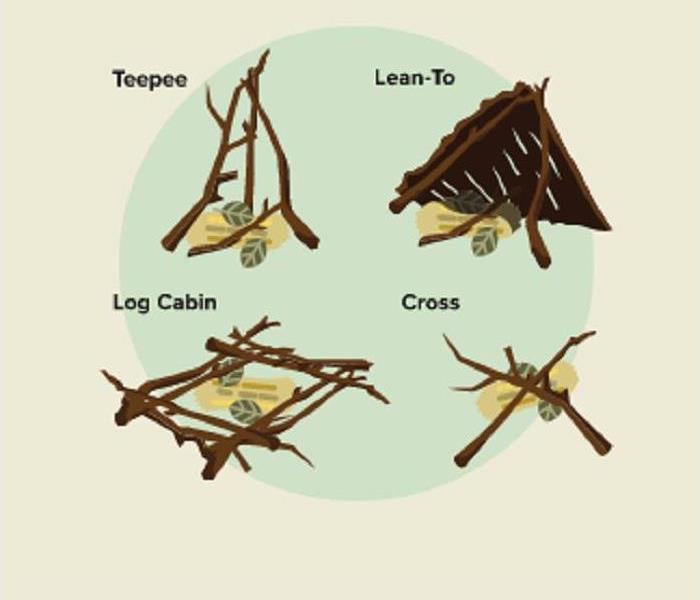 Choose between these four kinds of kindling when building your fire
Choose between these four kinds of kindling when building your fire
Enjoying the great outdoors during the summertime can be fun. Nothing says summer quite like sitting around the campfire sharing stories and making s’mores. But that campfire is also a huge responsibility. Everyone in California knows the damage a wildfire can bring, so before you go out and make a campfire, it’s important you learn how to be safe when building your campfire or bonfire, whether in the woods or in your backyard.
PICK THE RIGHT CAMPFIRE LOCATION
- If the campground or area where you are prohibits campfires, then DO NOT build one. Digging pits can be prohibited due to any number of various concerns. Whatever the reason, there is a reason – so be sure to follow the rules.
- DO NOT build a campfire under hazardous or dry conditions. Dry air increases the risk of wildfires.
- If there is an existing fire ring or pit, then use that. If not, choose a site that is at least 15 feet from tent walls, trees, shrubs, or other flammable objects. Be mindful of low hanging branches.
- When building a campfire or bonfire, choose a location that is open and away from heavy fuels such as logs, brush, or decaying leaves.
- Always be aware of wind strength and direction. If the wind picks up and direction changes, there could suddenly be embers and ashes flying into easily flammable areas. Choose a spot that is protected from gusts of wind.
HOW TO PREPARE A CAMPFIRE PIT
There may not always be a campfire pit already prepared when you arrive on a campsite. If that’s the case, don’t panic! Follow these simple steps to preparing your own fire pit.
- Start off by clearing an area that is 10 feet in diameter around the campsite. Remove any grass, twigs, leaves, or firewood while you do so.
- Dig a pit about one foot deep in the dirt or sand.
- Circle the pit with rocks and you’re ready to go!
BUILDING YOUR CAMPFIRE
Your pit is ready, now it’s time to build your fire!
- Before you do anything, make sure you have a source of water, a bucket, and a shovel nearby at all times.
- You’ll have to gather three types of wood from the ground. Tinder can be small twigs and dry leaves, grass, and needles. For kindling you should look for sticks smaller than 1″ around. Your fuel will be larger pieces of wood. Keep these stacked upwind and away from the fire.
NEVER cut whole trees or branches, dead or alive. Live materials won’t burn, and you’ll also be damaging the forest. Dead standing trees can often be homes for birds or other wildlife. - Loosely pile a few handfuls of your tinder in the center of the fire pit.
- Add the kindling in one of four methods: Teepee, Lean-to, Cross, or Log Cabin.
- Ignite the tinder with a match or lighter. (If you use a match, wait until it is cold to discard it onto the fire)
- As the fire grows, continue to add more tinder.
- Blow lightly at the base of the fire.
- Add kindling and fuel (the larger firewood) to the keep the fire going.
- Now that you have built your fire, keep it small and under control.
EXTINGUISHING YOUR CAMPFIRE
- If possible, allow the wood to burn completely to ash.
- Pour A LOT of water onto the fire. Drown ALL embers, not just the red ones. Keep pouring until the hissing sound stops.
- If you do not have water, stir dirt and sand into the embers with a shovel to bury the fire.
- Using your shovel, scrape any remaining sticks and logs to remove any embers. Make sure there aren’t any embers are exposed or still smoldering.
- Continue to add water, dirt or, sand, and stir with a shovel until all material is cool.
- If it’s too hot to touch, it’s too hot to leave.
There you have it! Have fun but most importantly, be safe when building a campfire!!
source: https://smokeybear.com/en/prevention-how-tos/campfire-safety
How to Keep Your Pets Safe in the Event of a Fire
7/12/2017 (Permalink)
Approximately 500,000 pets are affected by house fires each year. Many house fires are caused by pets, especially when left home alone. Read over these tips to help prevent any accidental fire started by your pets and for keeping your pets safe in the event there is a fire in your home. Make sure you include your dog, cat, or other pets in your family's emergency plan.
Prevent Your Pets From Starting A Fire
- Beware of candles and other open flames. Dogs are curious creatures and may take interest in a flickering flame. If you do have any open flames in your home at any time, be sure to never leave them unattended and to keep an eye on your pets. If you're using a fireplace, consider getting a fireplace screen to protect pets when sleeping in front of the fire. Also make sure the fire is completely out before heading out or going to bed. Small sparks and coals can get through a screen.
- Secure wires and cords. Pets are often tempted to chew on loose wires and cords. Exposed wires can be a fire hazard, so consider securing any electrical objects so that their cords are out of reach.
- Don't use glass bowls for your pets' water. When filtered and heated through glass, the sun's rays can ignite the wood beneath the bowl and set a deck in flames. Try using a stainless steel or ceramic bowl instead.
Keep Your Pets Safe After/During A Fire
- Place a pet fire sticker on the door or window. In the event of a fire when you're away, having a pet sticker will help rescuers know how many pets to look for, saving valuable time and hopefully your pets.
- Use monitored smoke detectors. Pets left home alone can't escape on their own when there's a fire. Monitored smoke detectors contact emergency responders when you're not home and add an extra layer of protection beyond that of battery-operated smoke alarms.
- Keep pets near entrances when you're away from home. Keep collars (with ID tags) on your pets at all times and leave leashes by the entrance or somewhere easy to find in an emergency. This will help firefighters to find and rescue your pets when they arrive.
- Know where your pets' hiding spots are. It's important that you can find your pets quickly if there's a fire. Know where your pets like to sleep and especially where they like to go when they are scared or anxious (under the bed or hidden in a quiet corner of the house somewhere)
- Have an emergency plan in place and make sure everyone in the house knows what to do in the event of a fire. Know who will be in charge of getting your pets outside safely. Have someone in charge of leashes and pet carriers so that they can be safely secured once you're outside. In the event that you can't find your pet when exiting, leave doors and windows open on your way out and call to them so that they come out on their own.
- Practice fire drills with your pets. It is important to include your pets in the family fire drills. Practice finding them and getting out of the house. Also practice the "open access" scenario where you leave an exit open (preferably the one they're most comfortable with) and call to them to come out of the home. The more you practice, the more likely they are to come out in the event of an actual fire.
If you have any questions or require restoration services due to fire damage in your home, call SERVPRO of Tustin at (714)480-1340. Our crews are available 24/7 for services.






 24/7 Emergency Service
24/7 Emergency Service
